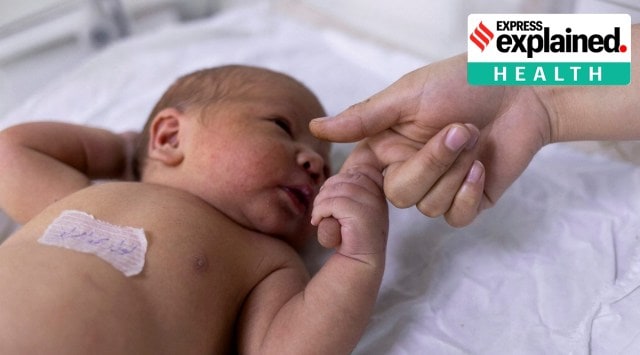Explained: What is Sudden Infant Death Syndrome?
A new study on Sudden Infant Death Syndrome (SIDS) could potentially pave the way for early intervention and diagnosis. Health experts, however, warn there is still a long way to go before the true cause of SIDS is identified.
 A newborn baby holds on a nurse's finger at the maternity ward of the children hospital in Kabul, Afghanistan. (Reuters Photo/File)
A newborn baby holds on a nurse's finger at the maternity ward of the children hospital in Kabul, Afghanistan. (Reuters Photo/File) A team of scientists from Australia have found that babies at risk of the mysterious Sudden Infant Death Syndrome, or SIDS, generally have low levels of an enzyme called butyrylcholinesterase (BChE) in their blood.
SIDS, also known as ‘cot death’, has claimed the lives of thousands of children across the West. In the United States, the Centers for Disease Control and Prevention (CDC) estimates that about 3,400 babies die suddenly and unexpectedly every year. Meanwhile, the United Kingdom reports about 200 such deaths annually, according to NHS data.
The illness, however, is shrouded in mystery — experts have been unable to identify what causes the deadly disease. While the Australian study could potentially pave the way for early intervention and diagnosis, health experts warn there is still a long way to go before the true cause of SIDS is identified.
So, what is Sudden Infant Death Syndrome?
Sudden Infant Death Syndrome refers to the sudden and unexpected death of an otherwise healthy infant under the age of one, generally while they are sleeping. Most SIDS-related deaths occur in infants between the age of 1-4 months.
According to the NHS website, parents can reduce the risk of SIDS by not smoking while pregnant or after the baby is born and ensuring that the baby is placed on their back when they sleep.
Some health experts have said that it is associated with issues in the part of an infant’s brain that controls breathing and waking up, CNN reported.
What does the new study say?
Published earlier this month in the journal eBioMedicine, the study assessed whether there was something inherently different in babies that succumbed to SIDS. The team that carried out the research was led by Dr. Carmel Harrington from the Children’s Hospital at Westmead, in Sydney, Australia, who lost one of her own children to SIDS nearly 30 years ago.
The researchers compared dried blood samples from 655 healthy babies, 26 babies who died due to SIDS and 41 babies who died of other causes. The team found that around nine of ten babies who died from SIDS had lower levels of BChE enzymes than the babies in the other two groups.
What is the BChE enzyme responsible for?
These enzymes are responsible for sending out signals that make a baby wake up, turn her head, or gasp for breath, the New York Times reported. It is part of the autonomic system, and controls functions like blood pressure and breathing.
The study refers to earlier research, which showed that animals in contact with second-hand smoke tend to exhibit lower BChE levels. It notes that several other factors and changes in the first six month of an infant’s life can also contribute to low levels of these enzymes.
“Babies have a very powerful mechanism to let us know when they are not happy. Usually, if a baby is confronted with a life-threatening situation, such as difficulty breathing during sleep because they are on their tummies, they will arouse and cry out. What this research shows is that some babies don’t have this same robust arousal response,” Dr Harrington told the Sydney Children’s Hospitals Network.
Why the study must be approached with caution
While the findings of this study are significant, scientists are still some time away from identifying the cause and cure of SIDS.
While the study has found that babies with SIDS reported lower BChE levels than infants without the disease, it has not laid down what a “normal” level of the enzyme looks like, a New York Times report points out.
Newsletter | Click to get the day’s best explainers in your inbox
Further, the study looks at blood samples that are at least a few years old. This means that they were unable to measure the absolute levels of the enzymes in fresh blood.
Even if babies are found to have low BChE levels, doctors have not been able to identify a treatment for this condition.
- 01
- 02
- 03
- 04
- 05






































